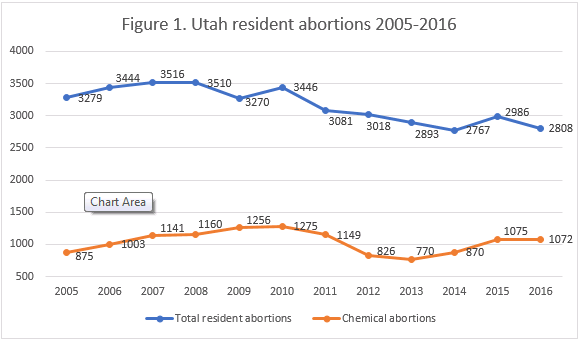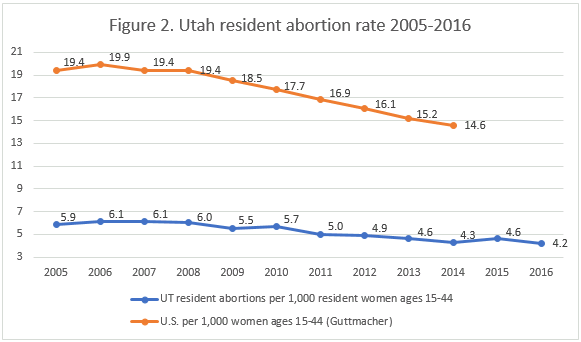Abortion Reporting: Utah (2016)
Utah’s annual abortion report for 2016, published online by the state’s Department of Health in April 2018, shows that abortions in the state continue to fall. In 2016, Utah’s state abortion rate reached a historic low.
Changes in Utah Abortions, 2015-2016

Abortion Totals and Trends
There were 3,008 abortions performed in Utah in 2016, down five percent from 3,176 in 2015. Abortions have increased by 40 percent since 1975, Utah’s first full year of abortion reporting; however, the report for 1975 acknowledges that many abortions may have gone unreported that year. Total abortions in Utah have dropped by 39 percent since 1989, the year with the highest number of reported abortions.
Utah reports the methods of abortion used on residents only, rather than on all women getting abortions in the state. Of the 2,808 abortions performed on Utah residents in 2016, 1,072 – 38 percent – were chemical (Fig. 1). This was basically unchanged from 2015, when 1,075 abortions were chemically induced, making up 36 percent of the abortions performed on Utahns that year. Utah has reported chemical or medication abortions since 1998, when just two chemical abortions were performed on residents. Utah’s resident abortion rate is the lowest ever reported at 4.2 abortions per resident women of childbearing age, down from 4.6 in 2015 (Fig. 2). From 1981 to 2000, Utah’s abortion reports included a small number of abortions performed on Utah residents in other states.
State Report Summary
Ninety-three percent of the abortions occurring in Utah in 2016 were performed on residents. An additional 200 women traveled to Utah from other states, including 97 women from Idaho. However, more detailed abortion statistics are provided for residents only. More than half of the Utah women getting abortions, 57 percent, were in their twenties, and 28 percent were in their thirties. There were 120 women aged 40 years or older and 276 between the ages of 15 and 19. The number of girls under the age of 15 was suppressed – Utah does not report aggregate numbers smaller than five. Age was not provided for 43 women.
White women were the largest racial group, accounting for 64 percent of the abortions performed on residents. Hispanic women made up the next-largest group at 21 percent. Most resident women had at least a high school diploma – 47 percent reported high school as their highest level of education, and 48 percent had completed more than 12 years of education. Just four percent reported fewer than 12 years, although level of education was not indicated for 31 women.
Twenty-four percent of the Utah women getting abortions were married, a higher percentage than in other states. Among the 39 states that have released abortion reports for 2016, a little over 14 percent of women were married, on average. An article from Deseret News on Utah’s 2015 report suggests that the cause of this disparity is not that married Utahns are more likely to choose abortion, but that unmarried Utah women are less likely to become pregnant and get abortions. The article also points out that women get married at younger ages in Utah than in other states, increasing Utah’s population of married women.
Slightly more than half of the women who had abortions, 53 percent, had never experienced a live birth before, while 18 percent had one previous live birth and 28 percent had two or more. More than three-quarters – 77 percent – had never had an abortion before. Sixteen percent had one previous abortion and just six percent had two or more. Altogether, 45 percent of women had no previous abortions and no previous live births. Information on prior births was not included for 11 women and information on prior abortions was not included for 29 women.
Almost 2,000 abortions, 69 percent, occurred at eight weeks gestation or earlier, with 1,040 of those performed between five and six weeks of gestation. Six were performed before five weeks of gestation and 901 between seven and eight weeks. Thirteen percent of abortions were performed between nine and 10 weeks, eight percent between 11 and 12 weeks, and four percent between 13 and 14 weeks. An additional four percent were performed between 15 and 20 weeks gestation. Seventeen abortions were performed after 20 weeks. Abortion in Utah is legal up to viability (usually around 24 weeks gestation) unless the mother’s life or a major bodily function is at risk, two doctors agree that the baby has a fatal condition, or the pregnancy is a result of rape or incest.
Eight abortions were known to have resulted in complications in 2016, although the report does not specify what kind of complications occurred or which types of abortion procedures caused them1. Utah does not require doctors or hospitals to report the complications they encounter, so it is very likely that complications identified after women had left the abortion facilities went unreported. Utah collects information on contraception use for the women seeking abortion, though this was not reported for most women. Two hundred thirty women reported using contraception in the past year, while 733 indicated that they did not use contraception. The pill was the most popular method, used by 106 women. Utah reports the number of abortions performed each month; the most occurred in March (283) and the least occurred in May (197).
Reasons for Abortion
Utah is one of only a few states to report why women get abortions, but the reasons listed offer little detail. In 2016, 15 abortions were performed because the mothers’ lives were in danger, and 41 were performed because of fetal abnormalities. By far the largest number of abortions, 90 percent, were “therapeutic.” Utah law does not define this term, but the report for the years 1974-1977 states that the “therapeutic” option combined the older categories of “psychiatric” and “emotional distress.” In 2016, there were 207 abortions categorized as “elective,” another term not defined. Some abortions were performed because the mothers were HIV-positive, though the exact number was suppressed. On Utah’s abortion reporting form that abortion providers fill out for each patient, rape and incest are both listed as possible reasons for abortion. However, the report does not state how many abortions were performed because of rape or incest.
A doctor who performs abortions in Utah suggested that the broad categories on the abortion reporting form could be interpreted inconsistently. One doctor might characterize an abortion as therapeutic, while another might consider it elective.
State Ranking
In a CLI study of state abortion reporting, Utah’s reports ranked in the top ten among the 50 states, the District of Columbia, and New York City. Still, the state has room for improvement. Utah could release its reports more quickly – 36 states published their 2016 reports before Utah did, and some have begun to release their 2017 reports. Utah could also collect and report information on its informed consent and parental consent processes. The state already reports comprehensive information on resident women who get abortions but could add information on all women undergoing abortion in the state, including the 97 women from Idaho.
Utah could also resume reporting of data points that it included in earlier reports, such as the physical characteristics of babies killed by abortion, whether any of the unborn children were viable, and the methods of payment used for abortion. Utah still collects data on the babies’ physical characteristics and payment methods. By adding more information to its abortion reports, Utah could give researchers, lawmakers, and citizens a clearer picture of the factors impacting abortion in the state.


- Statistics on abortion complications reported here represent a minimal number of deaths and complications, as this data is collected in a non-systematic and non-verifiable way. As such, this data cannot be used to calculate either an accurate abortion mortality rate, nor an accurate abortion complication rate for the state.























